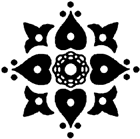 Clicking
on an image will open another window. You can use the second window
to scroll through all the enlarged images associated with this article
Clicking
on an image will open another window. You can use the second window
to scroll through all the enlarged images associated with this article |
The Henna Page Journal |
|
If a depression or psychosis did develop and woman felt that her child had been stolen and replaced by a supernaturally evil creature, (medical literature notes postpartum psychoses can take the form of the mother believing the child to be evil or malicious (Brockington et al, 2001)) rituals were be performed to retrieve the natural child so maternal bonding could be re-established. The infant believed to be a changeling, a mebeddel, had to be taken back to the jnun, supernatural spirits, and exchanged for the human child. The mother took the evil creature to a cemetery, looked for a demolished tomb, and put the changeling child there, with an offering of meat for the jnun. She withdrew, to avoid contact with the spirits as they came to collect the meat. As soon as the child cried, she reclaimed it, and washed it with holy water, and exclaimed, “I have taken my own child, not that of the Other People” (Legey, 1926: 154 – 5). Thus the postnatal ritual actions acted to buffer depression, and offered an option for reinstating maternal bonding in the instance of psychosis.
Popular Religious Ritual in Addition to Formal Religious Ritual and Standard Medical Practice Can Assist Immigrant Women After Childbirth Formal religious ritual addresses the metaphysical needs of a mother and child after a birth. A baptism, priest’s blessing, or circumcision secures the child’s soul into the formal religious community. The mother and child’s souls and their relationship with God are established and renewed through prayer, visits to a religious edifice, reading scripture, and blessings by clergy. These formal rituals and blessings are largely directed towards integrating the child into the metaphysical community, but there are no comparable formal rituals for the mother’s status adjustment. Mosques, temples, and the other expressions of formal religion may be established within an immigrant community as soon as there is enough economic base to support such. Though these supply the formal metaphysical needs of mothers and children, they may not provide the popular rituals for social and emotional support during the postpartum period. Adopting pluralist approaches to popular as well as formal religious practices may assist immigrant women in adjusting to motherhood with more moderate rates of postpartum depression than are currently experienced. Performance of postpartum rituals, particularly those which include henna, for South Asian, Middle Eastern and North African women during the forty days after birth may reduce their high levels of depression in their host countries to levels found in their indigenous countries. It is notable that these rituals are performed to provide physical and emotional assistance, and enable the woman to recuperate and bond with her infant through the period wherein the woman is most at risk for postpartum depression due to hormonal adjustment. In particular, the henna applications during this period require a woman to rest quietly for hours during the process, and abstain from household tasks that would spoil the patterns for three or four weeks following. This enforcement of inactivity ensures that a woman will rest during the period of hormonal stabilization and bond with her infant. If ritual performance can achieve similar reduction in depression to SSRIs, and do not directly interfere with medical practice, then religious pluralism may be practical medical policy. |
|
|
|||
| [Home] [How] [Why] [What] [Where] [FAQ] [Forum] | |||

